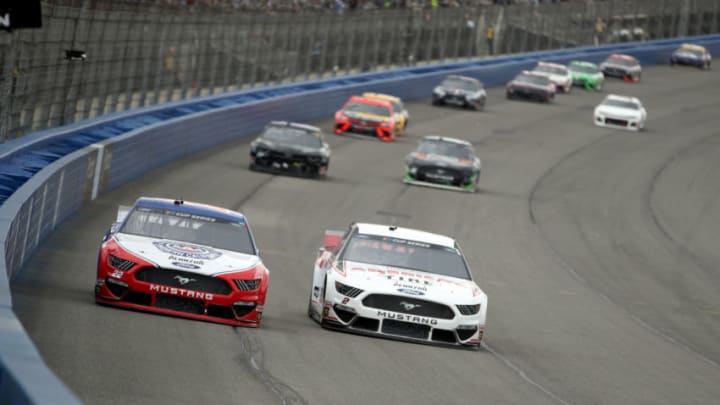Combined with worn race tracks, are the Goodyear Eagles improving the racing we have seen four races into the 2020 NASCAR Cup Series season?
From crazy starts and restarts to passing throughout the pack to great finishes, the start of the 2020 NASCAR Cup Series season has been different than last year’s. And no, it is not just because the “Big 3” of Kyle Busch, Kevin Harvick and Martin Truex Jr. have not yet won.
If you look at the Auto Club 400, the third race of the season at Auto Club Speedway, the green flag passes increased greatly, even though there were long runs throughout the entire race. NASCAR Loop Data showed that green flag passes went from 2,956 in 2019 (16.6 per green flag lap) to 3,968 in 2020 (21.2 per green flag lap).
The race at Las Vegas Motor Speedway actually showed a decrease from last year, but it provided some excellent racing. So what is the reason why we’ve seen better racing than in years past?
There hasn’t been much attention on it, but it could be the Goodyear tires working with some of these race tracks that have bumps and seams in them.
More from NASCAR Cup Series
- NASCAR Cup Series: New team set to compete in 2024
- NASCAR: Surprising name continuously linked to new seat
- NASCAR driver at risk of missing the Daytona 500?
- NASCAR set for rare appearance last seen 13 years ago
- NASCAR team adds third car, names driver for 2024 Daytona 500
Let’s look at the tire Goodyear used in the September race at Las Vegas Motor Speedway in 2019 and compare it to the one we saw a couple of weeks ago at the same venue.
A press release revealed that this year’s Goodyear Eagles from Las Vegas Motor Speedway featured a left side circumference that was down by three millimeters and the right side circumference that was up by one millimeter. But the tire pressures went down, which was a key factor in why the racing was better as a whole.
In the press release, Goodyear stated that tires that they brought to Las Vegas Motor Speedway were designed to “wear a little quicker. As race tires shed rubber, it allows heat to dissipate through the tread, keeping the tires cooler and better able to run at optimum performance.”
It added that “one other factor this week compared to last season’s races at Las Vegas is that Goodyear integrated construction updates to both its left and right-side tires. That enabled Goodyear to lower its minimum recommended air pressures on the left-side from 22 psi to 19 psi, meaning teams will have an extra tuning tool to be able to enhance grip levels.”
The tire degradation combined with the fact that Las Vegas Motor Speedway isn’t a smooth track with the bumps in turns one and two really provided some great racing.
Tire pressures were the same as last year at Auto Club Speedway at 18 psi on the left side tires while the right front tire had 45 psi and the right rear tire had 42 psi. But Auto Club Speedway has not been repaved since its advent in 1997, and these drivers really do slip and slide, especially with the bumps and seams.
Going back to the tires, the teams will typically run a lower tire pressure than normal to try to get better grip, but that could be a risk because putting less air could, according to the press release, lead to the “sidewall of the tire to over-deflect, creating damage that will lead to air loss later in a run.”
This was not what caused Ryan Blaney to pit in the final laps at Auto Club Speedway and lose a potential second place finish; that was a corded right rear tire.
As we look to the next few races, the race at Atlanta Motor Speedway will be an exciting race to watch on these Eagles. The track has not been repaved since its reconfiguration in 1997. It was supposed to be repaved after 2017, but the drivers said to keep it the way it is, because if you repave a track, it becomes a one-groove track.
Right now, any lane will work at Atlanta Motor Speedway. Likewise, Homestead-Miami Speedway hasn’t been repaved since its 2003 re-banking and is a multiple-groove race track. But Texas Motor Speedway was reconfigured before the 2017 season, and it is usually a one-groove race track.
As for the two other races that have been contested so far this season at Daytona International Speedway and Phoenix Raceway, it is a bit harder to judge them based on the tires since new packages were used compared to last year.
This year’s Daytona 500 was the first to be contested since restrictor plates were eliminated, and the race at Phoenix Raceway was the first short track race to be contested since the changes to the short track package were implemented ahead of the season.
The next NASCAR Cup Series race is scheduled to take place at Atlanta Motor Speedway this Sunday, March 15. The Folds of Honor QuikTrip 500 is set to be broadcast live on Fox beginning at 2:00 p.m. ET.
